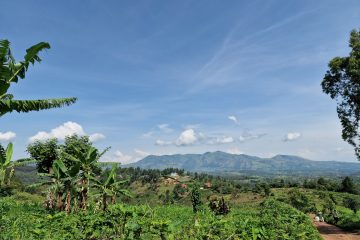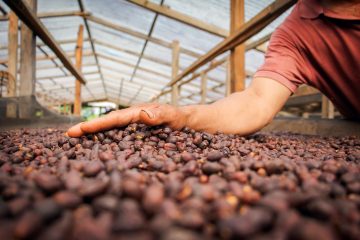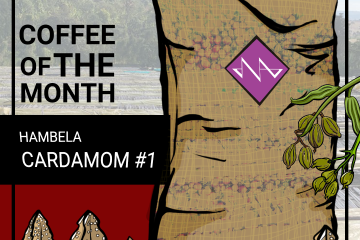General information
Ethiopia lies at longitude 30 – 50 degrees and latitudes 3-15 degrees. It covers an area of 1.1 million square kilometers. It’s the second largest populated country in Africa with more than 82 million inhabitants. The two main growing areas is in the west and south as well as there is production in Harar towards the east. Ethiopia can produce up to 300 tons of green coffee. More than 75% is sundried (naturals). They consume a significant amount domestically, and about 60% of production is exported. There is more than 1.1 million coffee farmers (smallholders) representing 95% of the production. The rest is mostly state owned farms, but the number of private estates are picking up. There is about 150 farms, 200 cooperative wet mills, 500 private wet mills, and thousands of private collectors for sundried coffees.

There are only farm owners and Unions, representing the Cooperatives, that’s allowed to export trace able coffees direct. All private wetmills, that buys cherries from small holders have to sell their coffees through the ECX (Ethiopian Commodity Exchange) where they are bought by private exporters and sold as non trace -able coffees by grade and area.
Ethiopia’s coffee growing areas are divided in to zones (region) and woredas (local community). A coffee from the Sidama Zone could typically be from the Bokasso Cooperative in Wonsho (the woreda). All Cooperatives relates to a Union that markets and sell the coffees on the Cooperatives behalf. Sidamo Cooperative coffees are sold and exported through the Sidamo Union, Yirgacheffe through the Yirgacheffe Union and the rest mostly through the Oromia Union. Every woreda (community) have a local office where the government and Unions have representatives to support and control the Coops and wet mills as well as oversee the trade of cherries. They do audits and follow up management at site. All coffees have to be inspected and graded by the ECX before moved to the warehouse and dry mill. This goes for both direct exports and coffees sold through the ECX.

The coffee regions
The west
The west represents about 46% of Ethiopias total production. It includes regions like Jimma, Kaffa, Illubabor, Wellega, Bench Maji and others. In the west you basically have three major types of farming. For higher altitudes it’s forest coffees grown “wild” or semi- forest coffes grown at smallholder blocks. Both are coffee of ancient trees, rarely pruned. Organic fertilizer can be common in smallholder blocks. For larger farms you have more recent varieties and dense planting . Mostly found in lower altitudes.

Except for certain areas the west are typically known to produce sundried coffees of average to lower qualities. Still, there are some great washed coffees coming out of this region these days. Technoserve, an NGO supporting farmers and cooperatives, are active in establishing washing stations in areas where they traditionally do sundried coffees. The quality potential is huge and some of these coffees have great and unique attributes not to be found elsewhere. The altitudes can be more than 2000 masl, with perfect growing conditions. As they represent a great range of flavor profiles this development is worth following up closely.
The South
The well-known areas in the south, Sidamo and Yirgacheffe is known for it’s clean, floral and acidity driven washed coffees and “high quality” sundried with genuine and unique fruit and berry flavors. The south represents 45% of the total Ethiopian coffee production. Most of the Cooperatives in these areas are Organic and/or Fair-trade certified as well as UTZ and Rainforest Alliance is picking up. Majority of the quality coffee is sold as Sidamo or Yirgacheffe Grade – 2 for washed and Grade – 3 for unwashed. There are mainly small family plots of both recently planted trees of improved varietals and traditional old varieties. Organic fertilizer is common, pruning less common.

Yirgacheffee has become the brand name of coffees in the Gedeo Zone bordering Sidamo. A lot of the coffee in Yirgacheffe is shade grown at high altitudes. The area is pretty dense in terms of smallholders and wet mills. There is 23 cooperatives in the area, with a total of about 60000 members. They cover about 28500 hectares of coffee and produce about 1300 tons of greens. Majority of the coffees are washed, but there is small amounts of sundried coffees as well.
Sidamo covers a pretty big area with very different growing conditions. You can find highland areas of forest coffees in remote places as well as pretty dense production in the more well known areas like Aleto Wondo, Darra and Dale. There is currently about 50 Cooperatives in Sidamo with a total of 90000 members and a bunch of privates. The cooperatives are able to produce about 2000 tons of greens. Both washed and sundried is common, but here as in Yirgacheffe the majority of the coffee is washed.
The East
Harar accounts for 10% of Ethiopias coffee production and is all sundried. According to history the coffee grew wild here long time before it was cultivated. Coffees from Harar are widely known for its typical blueberry notes and intense fruit flavors. Still I have to admit it can be difficult to find a totally clean and transparent coffee from this area, but thats according to my personal preference and our requirements. If they are able to control the process and trade I’m sure there is potential here. Smallholders typically grow the coffee, and most of it’s traded by local collectors and sold through the ECX. They are famous for the so called varietal Harar longberry.
Coffee varietals
The varieties are referred to as Ethiopian Heirloom and seem to be a myriad of local native Typica hybrids and new improved varietals based on the old strains. In Sidama they grow Sidamo-type, in Yirgacheffe Yirga-type, in Limu it’s different selections of Limu-type and so on. There are selections with numbers such as Selection 74110 and 74140, F59, some areas grow Geisha, there are varieties with local names such as Gammadro Local and hundreds of others. You have different type of farming that will determine if you have old native varieties or new selections. The Typica variety is known to be a low yielding plant compared to for instance Bourbon varieties.

Growing conditions and production
In general the production of the smallholders are low at about 1,5 kg of cherries per tree. However, this year the crop is big and yields are therefore closer to 3 kg of cherry pr tree. This will be slightly above a 1/2 kg of greens. A typical farmer could have a half hectar and about 600 trees or less. Organic fertilizer is in general common except from some areas with “wild” forest coffees. Pruning is less common. Many of the trees are extremely old, and not always able to give a great yield, but in general a lot could be done with right pruning, mulching and inputs. You often see huge trees hardly carrying cherries. There is a bi annual cycle and some trees only carries crop every second year.
Farming
Forest coffees • “wild” grown coffees from ancient trees that are never pruned or fertilized. It’s allocated to the farmers by the local government and often farmed communally. Mostly found in the west in areas such as Kaffa and Illubabor. It represents about 10% of Ethiopia’s production and gives a yield at 250 kg of greens pr hectare on the average.
Semi forest farming • Coffee of forest origin transferred to family smallholder plots. Organic fertilizer is common, but hardly any pruning. Normally found in the west. Represents 35% of Ethiopia’s production and gives a yield at 350 kg of greens pr Hectare on the average.

Garden farming
• More recently planted trees of both traditional and improved varietals. Organic fertilizer is common, pruning less common. Farmed on family smallholder plots like in other East African countries. Dominant in Sidama, Yirgacheffe and Harar. Represents 50% of Ethiopia’s production and gives a yield at 450 kg of greens pr Hectare on the average.
Plantation farming
• Mainly recently planted coffee of improved varietals. Production is more dense and it’s farmed under intensive management. Most common in the lower altitudes in the west. Farms are mostly state owned but private investments is picking up. Represents 5% of Ethiopia’s production and gives a yield at 650 kg of greens pr Hectare on the average.

Cherry reception
The main harvest normally starts early November and they harvest throughout January. The majority of the sundried coffees are sold to local collectors. But private wet mills and cooperatives can purchase cherries and do both processes. For the cherries going to wetmills there are different ways depending on where you are. In the south the cherry purchase is normally done at collection sites. Even the cooperatives buy their cherries from members, and non-members at the local collection site, side by side with local collectors reselling to the private mills. It’s regulated by law, and in Sidama it’s not allowed to buy cherries elsewhere. This creates a competition. You can often see the privates have higher buying price than the cooperatives, but the quality can be poorer. The incentives for a member to sell to the Cooperatives are the dividend they will get as a second payment after the Coops receive their premium for the coffee. Current price for a kg of cherrie is 75 cts and the higher dividend can reach 20 cts pr kg of cherry delivered. This allow the Cooperatives to be more strict on quality as well. For the Cooperative wetmills in the west the cherries can be delivered straight to the washing stations, but even here the members have collection sites for the more remote areas.

Fermentation, washing and drying
Wet fermentation The traditional way of process washed coffees in Ethiopia is wet fermentation. The coffees are pulped by Agaarde four disc pulper or similar. The coffees are after their pulped separated in water by density in to three different grades. The heavier beans goes straight to the fermentation tank for grade 1, second and third grade is pulped again before separated in to the fermentation tank for grade 2, and grade 3 normally goes straight to the drying beds as low grades.

The tanks with grade 1 and 2 are filled with water to cover the parchment and floaters are skimmed off. They ferment under water up to 48 hours. Normally the water is changed two to three times during fermentation. After fermentation they are washed and graded again in the washing channels before soaked in water for up to 24 hours. The process requires huge amounts of water and takes up a lot of space for a long time. It’s also a risk of tainted coffee if the water is polluted. We have seen some great coffees processed this way, and if done properly it can be beautiful. Still, there are trials done to see if the coffees can be dry fermented (without added water) and this can reduce fermentation time to about 30 hours. Coffees will then be washed and soaked in clean water up to 24 hours before going to the drying tables.

Parchment normally get skin dried for 4-6 hours and sorted for defects easier to be seen when parchment is wet. After skin drying they are normally dried on jute clothings on raised tables with steel net or bamboo constructed top layer. Normal drying time is 7 to 10 days depending on the weather. Parchment have to be covered in plastic at night and during mid day to avoid the intense sun cracking it up.

Eco pulpers
Many of the pre existing Cooperatives will probably change from traditional disc pulpers to eco pulpers. All new Cooperatives structured by Technoserve do the same. They mainly uses Penagos, a compact eco pulper with demucilager. After the cherries are pulped and demucilaged they goes straight to the soaking tank in clean water to stay over night or longer.
Parchment are skin dried, sometimes under shade in the Western regions, parchment are hand sorted before moved to drying tables under sun. Again coffees have to be covered up at night and during mid day. Early in the season they have some challenges with short rains during drying and have to be careful and quick to cover up the coffees in time.

Sundried (unwashed)
Cherries should be spread out in thin layers on raised tables and constantly moved during the first stage. Drying should go quickly first couple of days and then slowed down. Cherries are dried up to 15 days. Except from a few producers the cherrie quality seems to be poor as they are not separated and the layers during drying can be to thick. The Cooperatives are able and willing to do high quality on demand. This coffees are hulled at local mills before they go in to the Governmental dry mill or to private exporters for cleaning and grading.

Parchment separation
Normally they will mix the daily lots randomly after drying according to the different grade coming from the pulper. All the Technoserve assisted Coops uses trace ability sheets to monitore and evaluate the process. After drying the parchment is normally stored in local warehouses at site until they have enough to send to the mill. Lot separation can vary, but 225 – 420 bags of parchment is normal for the pre excisting cooperatives in the south, and 150 bags of parchment more common in the west. We hope to work with the Coops to downsize the parchment lots to be able to separate the better qualities. Coffees are then trucked to the local ECX to get graded before it’s moved to the assigned warehouse at the mill. All coffees through the Unions are currently trucked and stored in Addis, and the climate and warehouse conditions are acceptable. They are constructing a new mill and warehouse for the Unions in the south.

Grades and qualitites
The system of grading in Ethiopia is a little confusing as it is a mix of number of defects, processing method and cup quality. The standard grades for export is Grade-1 to Grade-5. Normally washed coffees will be exported as Grade-1 (uncommond) and Grade -2 (standard). Unwashed will be exported as Grade-3 to Grade-5. After processing the coffees as grades 1-3 at the wetmills it will be analyzed and approoved at the local ECX lab. A typical coffee from Yirgacheffe or Sidamo approoved as Grade-2 for exports will be a mix of the grade 1 and 2 from the wetmill. Exportable coffee approoved as Grade-1 would normally be a special preparation. Here it’s only 0-3 defects allowed. Standard dry mill preparation for Grade-2 is screen size 14 up and 4-12 secondary defects pr 300 grams. An unwashed coffee from Sidamo can be sold as Grade-3, with the same requirements for screen size and defects as for washed coffees Grade-2. Unwashed coffees from Jimma and the other western regions will normally be sold as Grade-4 or 5.
As a buyer it’s possible to ask for improoved preparations if you are willing to pay the extra cost. We will probably over time do some top quality Grade-2 and Grade-3’s with 0-3 defects and screen size 15 up.


